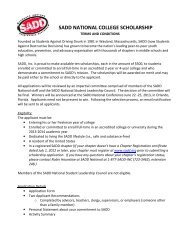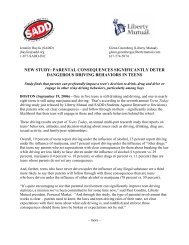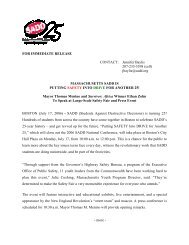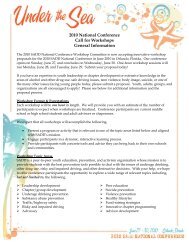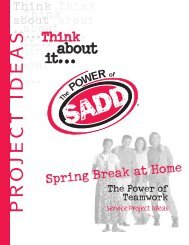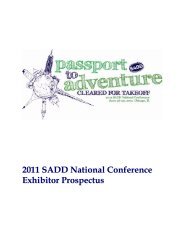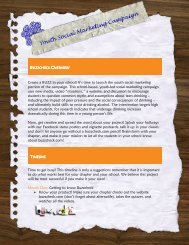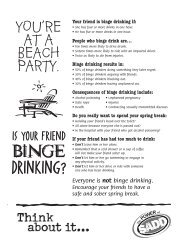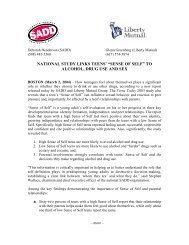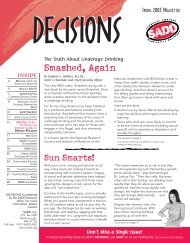positive risk-taking cuts alcohol and drug use among teens - SADD
positive risk-taking cuts alcohol and drug use among teens - SADD
positive risk-taking cuts alcohol and drug use among teens - SADD
You also want an ePaper? Increase the reach of your titles
YUMPU automatically turns print PDFs into web optimized ePapers that Google loves.
Deborah Burke Henderson (<strong>SADD</strong>)<br />
Glenn Greenberg (Liberty Mutual)<br />
1-877-<strong>SADD</strong>-INC (617) 574-5874<br />
POSITIVE RISK-TAKING CUTS ALCOHOL<br />
AND DRUG USE AMONG TEENS<br />
National Study Links Adolescent Risk Profiles to Substance Use,<br />
Academic Performance, <strong>and</strong> Mental Health<br />
Teens Shatter “Myth of Risk”<br />
BOSTON (November 29, 2004) – Teenagers who challenge themselves by <strong>taking</strong> <strong>positive</strong><br />
<strong>risk</strong>s, such as joining an athletic team or volunteering to perform community service, are<br />
more likely than those who don’t to avoid <strong>alcohol</strong> <strong>and</strong> other <strong>drug</strong> <strong>use</strong>, according to the Teens<br />
Today 2004 report released today by <strong>SADD</strong> <strong>and</strong> Liberty Mutual Group. Teens’ “Risk<br />
Profiles” (Risk Seekers <strong>and</strong> Risk Avoiders) are also linked to their academic performance<br />
<strong>and</strong> overall emotional well-being.<br />
“For years, parents <strong>and</strong> educators have steered young people toward activities they believe<br />
will help prevent poor decision-making. Now we have ‘proof <strong>positive</strong>’ it works,” said<br />
Stephen Wallace, chairman <strong>and</strong> chief executive officer of the national <strong>SADD</strong> organization.<br />
“Although <strong>teens</strong> are hard-wired to take <strong>risk</strong>s, this research makes clear that those <strong>risk</strong>s don’t<br />
have to be dangerous ones.”<br />
The Myth of Risk<br />
While many adults have long linked <strong>risk</strong>-<strong>taking</strong> with negative behavior, a majority of<br />
young people (52 percent) believe that <strong>risk</strong>-<strong>taking</strong> refers to <strong>positive</strong> activities.<br />
Significantly, the Teens Today 2004 report reveals that <strong>teens</strong> who take <strong>positive</strong> <strong>risk</strong>s (Risk<br />
Seekers) in their lives, their schools, <strong>and</strong> their communities are 20 percent more likely than<br />
<strong>teens</strong> who do not take <strong>positive</strong> <strong>risk</strong>s (Risk Avoiders) to avoid <strong>alcohol</strong> <strong>and</strong> other <strong>drug</strong>s <strong>and</strong> 42<br />
percent more likely to avoid drinking beca<strong>use</strong> of concerns about academic performance.<br />
Risk Seekers are also more likely than Risk Avoiders to:<br />
• Describe themselves as responsible (89 percent vs. 79 percent), confident (82 percent<br />
vs. 75 percent), successful (88 percent vs. 73 percent), <strong>and</strong> optimistic (76 percent vs.<br />
63 percent).<br />
• Report they often feel happy (92 percent vs. 85 percent).<br />
• Consider potential negative outcomes of destructive behaviors.<br />
♣ Be more likely to think they will get hurt (79 percent vs. 65 percent).<br />
♣ Be more likely to think they will get caught (79 percent vs. 70<br />
percent).
Teens Today / 2<br />
♣ Be more likely to think they will be held accountable (84 percent vs.<br />
75 percent).<br />
These <strong>teens</strong> are also less likely to cite mental states such as boredom <strong>and</strong> depression.<br />
Positive Risk-Taking by Teens<br />
“This important new research suggests that we can help <strong>teens</strong> to reframe <strong>risk</strong>-<strong>taking</strong> as<br />
potentially <strong>positive</strong> <strong>and</strong> redouble our efforts in encouraging them to test their limits in<br />
constructive ways, as opposed to destructive ways,” stated Paul Condrin, Liberty Mutual<br />
executive vice president, Personal Market.<br />
The Teens Today 2004 research identified three broad categories of <strong>positive</strong> <strong>risk</strong>-<strong>taking</strong>.<br />
1. Life Risks<br />
Social – e.g. joining a club or group<br />
Emotional – e.g. asking someone on a date or sharing feelings with friends<br />
Physical – e.g. rock climbing<br />
2. School Risks<br />
Academic – e.g. <strong>taking</strong> an advanced placement course<br />
Athletic – e.g. trying out for a sports team<br />
Extracurricular – e.g. running for student council<br />
3. Community Risks<br />
Volunteering – e.g. helping the elderly or homeless<br />
Mentoring – e.g. working with younger children<br />
Leading – e.g. starting a business or charity<br />
What Does This Mean for Families <strong>and</strong> Friends?<br />
Both middle school (52 percent) <strong>and</strong> high school (42 percent) <strong>teens</strong> are most likely to say<br />
their parents do the most to <strong>positive</strong>ly influence them to challenge themselves, followed<br />
closely by their friends (29 percent in middle school <strong>and</strong> 36 percent in high school). These<br />
findings are consistent with past Teens Today studies that have shown that parents <strong>and</strong> peers<br />
have tremendous influence on teen behavior. For example, <strong>teens</strong> who report regular, open<br />
communication with their parents about important issues say they are more likely to try to<br />
live up to their parents’ expectations <strong>and</strong> less likely to drink, <strong>use</strong> <strong>drug</strong>s, or engage in early<br />
sexual behavior.<br />
Parents <strong>and</strong> peers can help <strong>teens</strong> to take <strong>positive</strong> <strong>risk</strong>s by:<br />
• Modeling inclusive social behavior <strong>and</strong> coaching peer-to-peer social skills;<br />
• Identifying <strong>and</strong> discussing emotional reactions to issues or events;<br />
• Encouraging focus on academics <strong>and</strong> consideration of higher level courses;
Teens Today / 3<br />
• Supporting club or activity membership <strong>and</strong>/or athletic participation; <strong>and</strong><br />
• Involving family <strong>and</strong> friends in community-service project(s).<br />
Methodology<br />
Atlantic Research <strong>and</strong> Consulting, Inc. conducted focus groups <strong>and</strong> in-depth interviews<br />
(IDI’s) with <strong>teens</strong> on March 29 (Phoenix) <strong>and</strong> March 31 (Charlotte, North Carolina).<br />
Additional IDI’s were conducted on April 1 <strong>and</strong> 2 (Tampa, Florida) <strong>and</strong> April 8 <strong>and</strong> 26<br />
(Boston). A total of 3,574 <strong>teens</strong> from 41 schools across the country completed the<br />
quantitative study during the months of May <strong>and</strong> June.<br />
The data was weighted by census region to ensure that it was representative of the US<br />
population. The findings in the report are based on the completion of 3,574 interviews <strong>and</strong><br />
can be interpreted at a 95 percent confidence interval with a +/- 1.3 percent error margin.<br />
Analysis of study subgroups is subject to wider error margins. Percentages in the report may<br />
add to more or less than 100 percent due to rounding error or occasions when multiple<br />
response answers were accepted.<br />
<strong>SADD</strong> <strong>and</strong> Liberty Mutual Group<br />
<strong>SADD</strong>, Inc. (Students Against Destructive Decisions) sponsors peer-to-peer education <strong>and</strong><br />
prevention programs in middle schools <strong>and</strong> high schools nationwide.<br />
Liberty Mutual Group is one of the largest multi-line insurers in the property <strong>and</strong> casualty<br />
industry. Offering a wide range of products <strong>and</strong> services, including private passenger auto<br />
<strong>and</strong> homeowners insurance, Liberty Mutual Group employs 37,000 people in more than 900<br />
offices throughout the world.<br />
<strong>SADD</strong> <strong>and</strong> Liberty Mutual make available a number of important family communication<br />
tools:<br />
• <strong>SADD</strong>’s Contract for Life <strong>and</strong> “Opening Lifesaving Lines” brochure<br />
• <strong>SADD</strong>’s Family Focus speakers program<br />
• Liberty Mutual’s “Avoiding Collisions: How to Survive the Teenage Driving<br />
Years” video <strong>and</strong> brochure<br />
• <strong>SADD</strong>/Liberty Mutual “Guidelines for Good Family Communication”<br />
brochure<br />
For more information or to receive materials, contact:<br />
<strong>SADD</strong>, Inc., 1-877-<strong>SADD</strong>-INC, www.sadd.org<br />
Liberty Mutual Group, 1-800-4-LIBERTY, www.libertymutualinsurance.com.<br />
###




